TIPS TO PREVENT & TREAT TAILBONE / COCCYX WOUNDS.
Protracted periods spent without relieving pressure on the weight-bearing areas are a common problem and a leading cause of skin breakdown. The coccyx is one of the most affected areas. Many internal and external factors make the Sacrum and Coccyx areas susceptible to pressure sores. This article addresses several important factors found outside of the body.
1) Susceptibility of skin over the bony prominences
2) Prolonged pressure
3) Excessive heat build-up or moisture
4) Improper positioning while seated in a wheelchair or recliner (sacral sitting)
5) Shearing forces created during repositioning or transfer while seated
6) Shearing forces created during repositioning in bed
WHAT IS THE COCCYX? - THE TALE OF THE TAIL
The coccyx is widely accepted as part of a rudimentary tailbone in humans that has lost its original function through evolution. Most people do not know they have a tailbone until they feel pain.
The coccyx is a small bone at the base of your spine. It is comprised of five fused vertebrae that create a well-defined bump on the back of the pelvis. This area serves as a vital connection point for many essential muscles and tendons. The coccyx bone is close to the skin's surface and therefore is very prone to skin breakdown.
PREVENT PROLONGED PRESSURE
A pressure injury can occur when there is unrelieved pressure between the skin and a support surface ie. seat or mattress, that exceeds capillary closing pressure. This pressure crushes off the capillaries and prevents the delivery of vital blood flow, oxygen, and nutrients the skin needs to stay healthy. Prolonged restriction of essential blood flow to the skin will cause cells to die resulting in skin breakdown. Boney prominences, where the skin is thin and bones are close to the skin's surface are particularly susceptible to pressure and skin breakdown. Prone areas include the coccyx (tailbone), IT's, sacrum, shoulder blades, heels, and more. Limited mobility puts a person at a much higher risk for pressure injuries.
TIPS - HOW TO AVOID PROLONGED PRESSURE THROUGH PRESSURE REDISTRIBUTION
Pressure redistribution is an essential key in the prevention of skin breakdown on the coccyx. It helps avoid prolonged restriction of blood flow to the skin. Whether in a wheelchair, recliner, or bed, there are numerous ways and tools to help redistribute pressure to the coccyx and improve blood flow.
Patient Led - For those able to reposition themselves
- Off-load/lift body weight off the wheelchair or recliner seat before repositioning.
- In a wheelchair or recliner, shift weight every 15 - 30 minutes - Using a reminder on a phone or APP is helpful.
- Reposition every hour if possible, two at most - Using a reminder on a phone or APP is helpful.
- It is essential to be able to maintain a proper seated or lying position
- Never shimmy, drag or slide across the surface of the seat or mattress
IMPORTANT NOTE: If one is not able to off-load their weight before repositioning, they are at higher risk of skin shear. Skin shear is a major factor in skin breakdown.
Caregiver-assisted repositioning - For those requiring assistance for repositioning
- Off-load/lift the patient body weight before repositioning
- In a wheelchair or recliner, shift weight every 15 - 30 minutes - Using a reminder on a phone or APP is helpful.
- Reposition every hour if possible, two at most - Using a reminder on a phone or APP is helpful.
- It is essential to be able to maintain a proper seated or lying position
- Use of a slide sheet, air-assisted repositioning device, patient belts, or other similar devices
- Never shimmy, drag or slide across the surface of the seat or mattress
IMPORTANT NOTE: If one is not able to off-load weight before repositioning, they are at higher risk of skin shear. Skin shear is a major factor in skin breakdown.
PRESSURE REDISTRIBUTION CUSHIONS FOR WHEELCHAIRS & RECLINERS
In addition to comfort and proper support, a coccyx cushion relieves pressure and off-loads pressure entirely via the cut-out under the tailbone. The type of cushion chosen depends on a person's mobility, condition of the skin, weight, ability to balance, and more. Make sure the cushion offers a low-shear / low-friction cover.
The list below offers a very basic description. Recently, new wheelchair and recliner cushions & hospital bed mattresses have been developed specifically to prevent and treat late-stage, chronic recurring coccyx wounds in a wheelchair and recliner. When determining which cushion or mattress is appropriate, speak with a wound care professional, seating specialist, or product expert.
- Foam Coccyx Cushion - For those under 250 lbs with mobility who are at low risk of skin breakdown
- Gel Coccyx Cushion or Specialized Low Profile Cushions - For those under 250 lbs with limited mobility who are at low to moderate risk of skin breakdown
- Gel-Flex or Foam Bariatric Coccyx Cushions - For those over 250 lbs with limited mobility who are at low to moderate risk of skin breakdown
- Self Adjusting Air Coccyx Cushion - For those under 250 lbs with limited mobility who are at moderate risk of skin breakdown
- Alternating Pressure Coccyx Wheelchair Cushion - For those under 250 lbs with very limited mobility who have stages I-IV pressure injuries or are at moderate to high risk of skin breakdown
- Alternating Pressure Recliner Cushion - For those under 250 lbs with very limited mobility who have stages I-IV pressure injuries or are at moderate to high risk of skin breakdown. Can also be utilized in a high-back wheelchair.
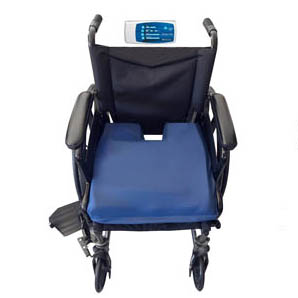
ALTERNATING PRESSURE COCCYX CUSHION
Advanced Pain Relief & Comfort for High Risk of Coccyx & IT Skin Breakdown
- • Alternating Pressure Therapy
- • Cut-Out for Pressure Offloading in Coccyx
- • Adjustable Comfort
- • For people at High to Medium Risk of Skin Breakdown
- • Available in a variety of widths customized to your chair
- • Variable cycle time
- • AC/DC pump for use with electric or 10 hour battery charge
- • Safety straps and non-skid bottom hold cushion in place
- • Supports up to 250 lbs. Bariatric Model Available
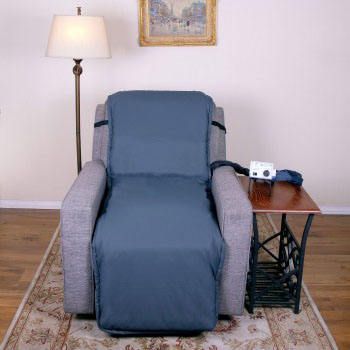
PREVENT & TREAT STAGES I-IV PRESSURE SORES
Advanced Pain Relief & Comfort for High Risk of Skin Breakdown
- • Alternating Pressure Therapy
- • Adjustable Comfort
- • For people at High to Medium Risk of Skin Breakdown
- • Available in a variety of widths 18", 20" & 22"
- • Fits all home recliners & lift chairs
- • Ultra-quiet Pump
- • Safety straps and non-skid bottom hold cushion in place
- • Head-to-heel protection
- • Sit or Sleep. Can be used 24/7 365
- • Supports up to 250 lbs. Bariatric Model Available
KEEP THE SKIN CLEAN, COOL AND DRY
The skin's microclimate (temperature, humidity, and airflow next to the skin surface) is an associated pressure injury risk factor. Temperature and humidity affect the structure and function of the skin increasing or lowering possible damage thresholds for the skin and underlying soft tissues. Heat and moisture build-up make the thin skin over the coccyx tailbone area more friable or easy to break. Just think of how soft and easily damaged the skin becomes in the warm, wet environment of the bathtub. Keeping the coccyx area cool and dry is very important.
TIPS ON HOW TO AVOID EXCESS HEAT AND MOISTURE
- Consistent repositioning helps to dissipate heat and moisture
- Incontinence can be a contributing factor in keeping skin clean and dry
- Use of a cushion with low air loss
- Maintain proper ambient temperature and humidity
PROPER SEATING POSITION IN A WHEELCHAIR OR RECLINER IS ESSENTIAL
It is difficult for those who are less mobile to achieve and maintain a proper seating position in a wheelchair, home recliner, or lift chair. Even with assistance, the patient may not be positioned properly.
Due to the seat depth of many home recliners and lift chairs, patients may not be able to sit properly on their own.
In a standard-size recliner chair (20" - 22" between the arms) for those 5' 9" or less, recliner seat depth becomes a crucial factor. To sit, a patient is positioned in front of the chair with the back of the calves touching the front of the recliner seat. The patient sits or is assisted to the seated position. Because of the seat depth and the person's height, there is often a large gap between the patient's hips and the back of the chair. To find comfort, the patient leans back without alleviating the gap. This forces them to sit directly on the tailbone or sacrum. It is known as Posterior Pelvic Tilt or more commonly sacral sitting. Sacral sitting causes additional pressure on the tailbone, pain, and prolonged unrelieved pressure leads to skin breakdown.
The image below illustrates how the depth of recliner chair seats may not allow a person to sit back far enough to achieve a neutral seated position.
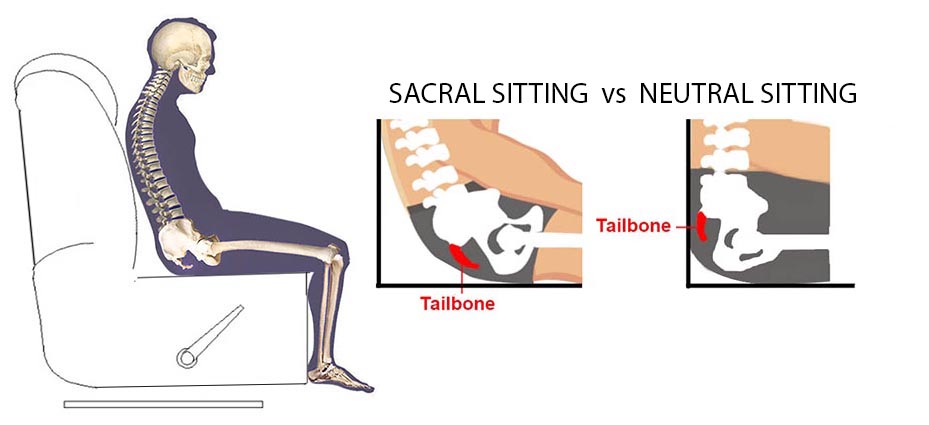
Notice the pelvic tilt and how the person is sitting directly on the coccyx and sacrum. This is very common!
Unrelieved pressure may result in skin breakdown on the coccyx and sacrum.
POSITIONING TIPS
- Sitting upright in a neutral position with body weight balanced
- Make sure hips are against the back of the recliner or wheelchair when seated.
NOTE: Attaining proper position may be more difficult in a recliner due to the recliner's seat depth in relationship to the patient's height.
- If alleviating the gap requires patient repositioning, take care not to cause skin shear.
- Ideally, with the patient's hips against the back of the chair, there should be a slight gap between the inside of the knee and the front of the recliner seat.
- A proper back cushion may help shorten the seat depth and improve patient positioning.
- It is essential that the patient is not leaning. Leaning can increase pressure.
- If possible, recline slightly. This helps offload weight from the tailbone/coccyx to the back.
- Purchase a pressure redistribution or positioning cushion that fits in your recliner or lift Chair.
HOW TO PREVENT COCCYX SKIN SHEAR IN RECLINER OR WHEELCHAIR?
Skin shear is a major factor in skin breakdown in the coccyx. Skin shear occurs when the skin and underlying bones move in opposite directions. This happens because the forces needed to break the friction between the body and the support surface when moving is greater than the skin can withstand. These forces moving in opposite directions can tear the skin. Repositioning is made far more difficult without the ability to lift one's weight off the support surface and can create injury to the skin. Skin shear often occurs during repositioning, shifting back in a chair or recliner when transferring.
TIPS
- off-load weight before repositioning
- Never shimmy, drag or slide across the surface of the seat or mattress
- Use of a slide sheet, patient belts, or other similar devices
- Use a therapeutic cushion that offers a low-shear / low-friction cover for skin protection
HOW TO PREVENT COCCYX SKIN SHEAR IN A MATTRESS?
It is entirely possible to develop a coccyx wound while on a foam or alternating pressure hospital bed mattress. Skin shear to the coccyx can occur when a person slides or is moved across the surface of the mattress by a caregiver. Use of a slide sheet, trandelenburg position if available or air-assisted repositioning device is very helpful.
One overlooked factor is when a person sinks into their mattress. This usually occurs when the head of the mattress is raised in the Fowler positions (30, 45, 60 degrees or more). (see image below) Body weight redistribution upon positional change often causes a person to sink into their mattress. Sinking into a mattress causes the person to slide deeper into the mattress. When the person slides there is a much higher risk of skin shear. Skin Shear is a leading cause of skin breakdown and bed sores. This is often seen in the coccyx or sacral area.
For a more detailed explanation please SEE ARTICLE - HOW SINKING INTO AN ALTERNATING PRESSURE MATTRESS CAN LEAD TO A BED SORE
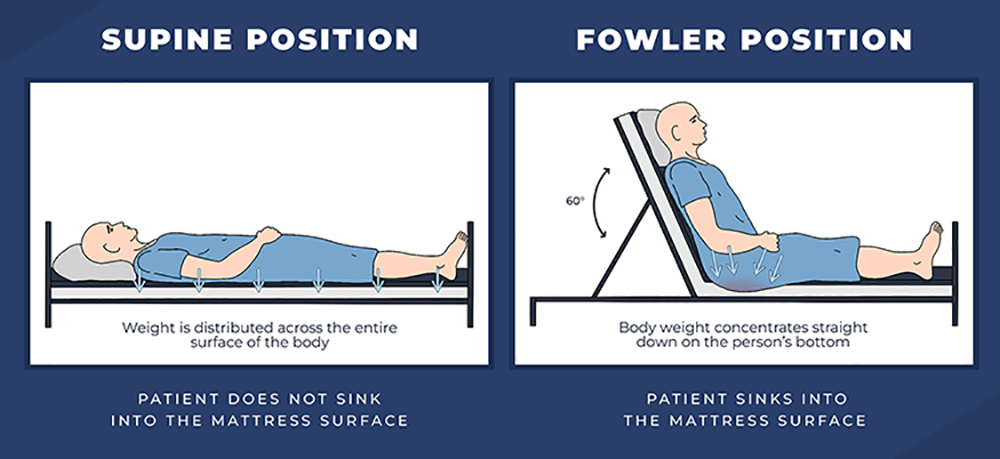
MOST PEOPLE SINK INTO THEIR MATTRESS UPON POSITION CHANGE. WHEN THEY SINK, THEY SLIDE, WHEN THEY SLIDE THEY CAN SHEAR THEIR SKIN. THIS IS A SIGNIFICANT CONTRIBUTOR TO SKIN BREAKDOWN IN THE COCCYX AND SACRUM AND MUST BE ADDRESSED.
TIPS - IF A PERSON IS SINKING WITH POSITION CHANGE
- Ensure the foam or air mattress is rated to properly support the patient's weight
- For an air mattress, check for proper setting and inflation.
- Check for air leaks in the bladders or hoses
- Check the age and output of the alternating pressure pump.
- Ensure the bed frame is not a contributing factor.
- If using a mattress overlay make sure it is supportive and there is no body impression
- Raise the person's knees
- Purchase an Alternating Pressure Mattress that offers an Automatic Fowler Adjustment. This newest advance helps prevent sinking, sliding, and skin shear in the coccyx by adjusting the pressure in the coccyx and sacral areas of the mattress. The Fowler function measures the degree of incline at the head of the bed and automatically adjusts.
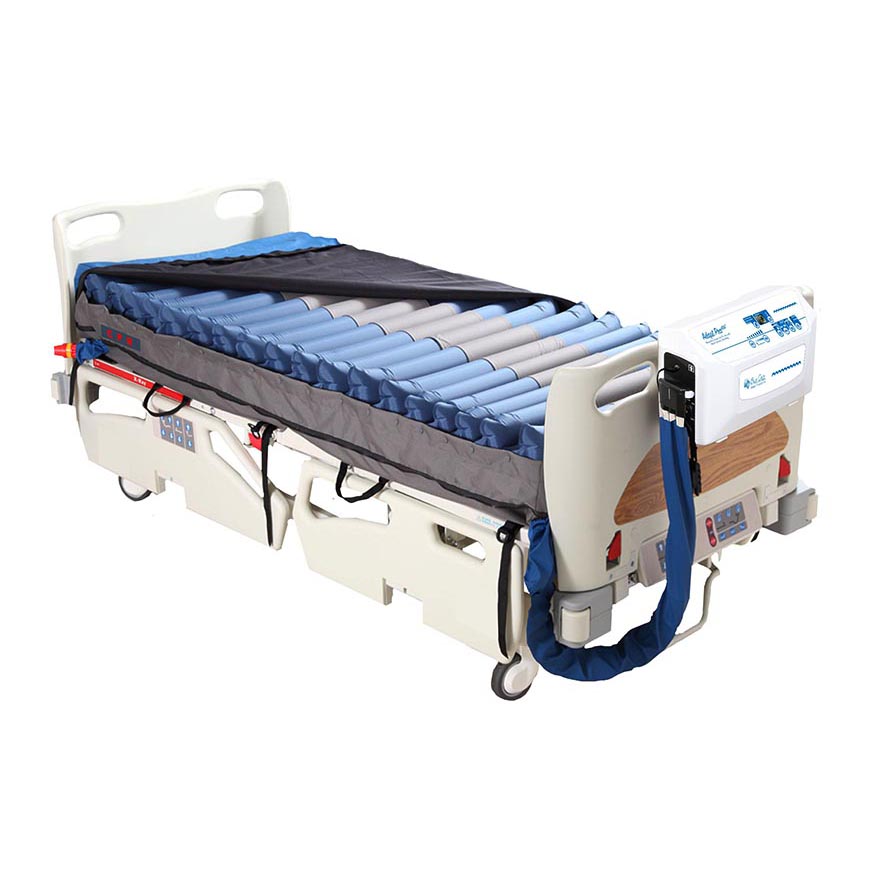
ADAPT PRO™ ELITE
Alternating Pressure Enhanced Low Air Loss & Automatic Fowler Adjustment
- • Alternating Pressure Therapy
- • Enhanced Low Air Loss therapy - Built into the cover
- • Automatic 2 Stage Fowler - Prevent sinking and skin shear
- • Patient Sensing Technology automatically adjusts mattress
- • Sealed bladders for better comfort and immersion
- • Precision Comfort Control
- • Static Care Mode with fall back
- • Available in a variety of widths 36", 42", 48" & Custom
- • Fits all hospital beds
- • Ultra-quiet Pump
- • Supports up to 350 - 800 lbs.
- • Optional Pulsation Mode and side bolsters
None of the information above is meant to diagnose or treat any condition. Always refer to your physician when seeking medical advice.

About the Author:
Jeff Adise has worked in the wound care industry for over 25 years. He is a product specialist and the developer of innovative therapeutic support surfaces for the treatment and healing of Stages I-IV pressure injuries in home recliners, lift chairs, wheelchairs, and beds. His innovative products are recommended for use by wound care specialists, physicians, and caregivers, across the US. In addition, Jeff is currently collaborating with a team of Doctors and Ph.D. researchers to develop and gain FDA approval for a groundbreaking new topical drug. The promising new drug has been shown to greatly improve the quality and speed of wound healing while reducing infection.
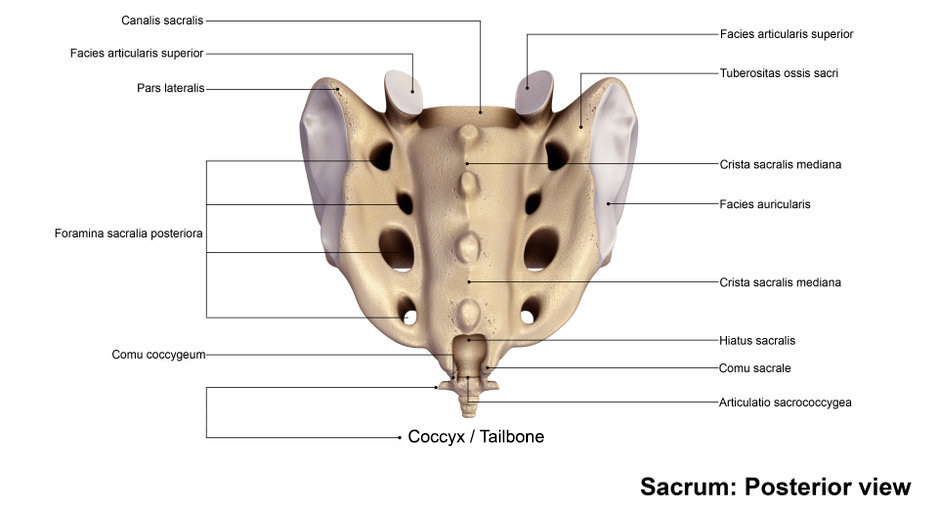
 © 2022 Comforts Best. All Rights Reserved.
© 2022 Comforts Best. All Rights Reserved.